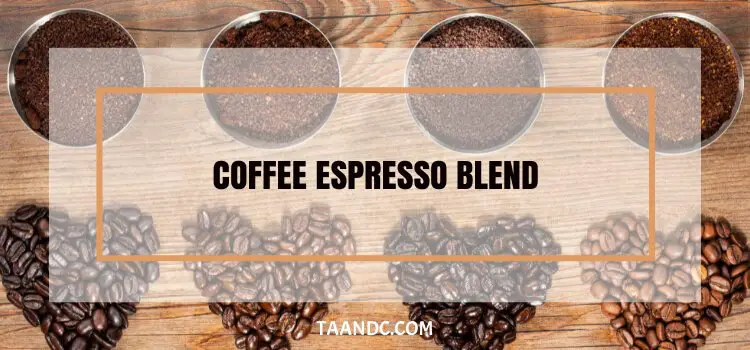For those of us who have embarked on the coffee connoisseur journey, one phrase can tingle our taste buds with anticipation Coffee Espresso Blend. This isn’t your everyday cup of joe; it’s a carefully crafted symphony of flavors that dances on your palate. Over the years, I’ve had the pleasure of savoring countless espresso blends, and let me tell you, each one is a unique experience. The world of coffee blends offers many options, from the bold and robust to the subtle and nuanced. Whether starting your day or seeking a mid-afternoon pick-me-up, a well-crafted espresso blend is the key to elevating your coffee game. Trust me; it’s a journey worth embarking on.

The Art of Crafting Coffee Espresso Blends
Coffee enthusiasts, welcome to the fascinating world of crafting the perfect coffee espresso blend. This section will explore the essential steps of transforming ordinary beans into a delightful espresso experience.
Selecting the Finest Coffee Beans for Blending
When crafting an exceptional espresso blend all starts with selecting top-quality coffee beans. You want to look for beans with unique flavor profiles that complement each other. For instance, consider the bright acidity of African beans, the mellow sweetness of Central American varieties, and the robust body of beans from South America. By blending these different beans, you can create a more complex and balanced espresso.
But it’s not just about origins; the bean’s roast level matters, too. Lighter roasts bring out the bean’s unique characteristics, while darker roasts add depth and richness. Experiment with various combinations to find the flavor profile that suits your taste.
Balancing Flavors
Balance is the heart of a great espresso blend. It’s like composing music; every note (or bean) should harmonize. To achieve this, you’ll need to fine-tune your mix by adjusting the ratio of each bean type. For example, if one bean is too acidic, you can balance it with a mellower bean. The goal is to create a well-rounded and enjoyable cup of espresso. Remember, achieving balance might require several iterations and tastings. It’s all part of the fun and creativity of blending.
Roasting Techniques for Espresso Blends
The final step in crafting your espresso blend is roasting. Each bean type may have different ideal roast levels. Light roasts preserve the bean’s unique flavors, while dark roasts add depth and intensity. Monitoring the roast closely is crucial to avoid over- or under-roasting, which can negatively impact the final taste. Some master roasters even use specific roast profiles for different beans within the same blend, allowing for more precise control over the flavor outcome.
Popular Coffee Bean Varieties for Espresso Blends
As we continue our exploration of the captivating world of coffee espresso blends, it’s time to dive into the diverse array of coffee bean varieties that play a pivotal role in crafting these exquisite brews.
Arabica vs. Robusta: Which is Best for Espresso?
One of the most common debates in the coffee world revolves around choosing Arabica and Robusta beans for crafting espresso blends. Arabica, known for its delicate flavors and aromatic qualities, is favored by many for its smooth, nuanced taste. Conversely, Robusta brings a bold, robust flavor and a rich crema, making it a popular choice for those who appreciate a more potent espresso.
The best choice between these two often comes down to personal preference. Many blends combine both to create a balanced profile, leveraging the strengths of each variety. Arabica contributes the subtle notes, while Robusta adds body and a sought-after caffeine kick.
Popular Coffee Bean Varieties for Espresso Blends
As we continue our exploration of the captivating world of coffee espresso blends, it’s time to dive into the diverse array of coffee bean varieties that play a pivotal role in crafting these exquisite brews.
Exploring Single-Origin & Multi-Origin Espresso Blends
Espresso blends can be further categorized into single-origin and multi-origin blends. Single-origin espresso is crafted from beans grown in a specific region, showcasing the unique characteristics of that locale. These blends offer a distinct taste that coffee connoisseurs appreciate.
Multi-origin espresso blends, on the other hand, combine beans from various regions to create a more complex flavor profile. They allow roasters to balance flavors and make a well-rounded espresso that appeals to a broader audience. The choice between single-origin and multi-origin blends depends on the desired flavor experience. Single-origin brings terroir to the forefront, while multi-origin offers versatility and room for experimentation.
Role of Specialty Beans
Specialty beans are the crown jewels of espresso blends. They are often grown at higher altitudes, hand-picked, and meticulously processed to highlight their unique qualities. These beans can add a layer of complexity and sophistication to your espresso blend. For instance, Ethiopian Yirgacheffe beans may introduce floral and citrus notes. In contrast, Jamaican Blue Mountain beans offer a mild and refined character. Specialty beans can elevate your blend to new heights, making it a memorable and unique experience for coffee lovers.
The Science Behind Espresso Extraction
Welcome to the intriguing realm where coffee meets precision: the science behind espresso extraction. This section will unravel the meticulous process that transforms your carefully crafted espresso blend into that perfect shot.
Espresso Brewing
Brewing espresso is an exacting science where every variable counts. It starts with the grind size, which should be acceptable and consistent. This fine grind allows for a balanced extraction by controlling the contact time between water and coffee. The water temperature is crucial; it should be around 195–205°F (90–96°C) for optimal extraction. Pressure is the next protagonist. Water is forced through the coffee grounds under pressure in your espresso machine, typically around 9 bars. This pressure extracts soluble compounds from the coffee, giving you that flavorful liquid gold.
Factors Influencing Espresso Extraction
A myriad of factors can influence espresso extraction. The coffee-to-water ratio, or dose, determines the concentration of your shot. Timing is also essential; a typical image should take 25-30 seconds to extract. Too fast, and it may taste sour; too slow, and bitterness might prevail. Water quality should not be underestimated. Impurities or inconsistent mineral content in water can affect the taste of your espresso. The cleanliness of your equipment is equally vital; a dirty machine can lead to off-flavors.
The Perfect Grind Size for Espresso Blends
Choosing the right grind size is akin to setting the stage for a perfect espresso performance. A grind that’s too fine can over-extract the coffee, resulting in bitterness. At the same time, a too-coarse task can lead to under-extraction, resulting in sourness. The ideal grind size depends on the beans, machine, and desired flavor profile.
Coffee Espresso Blend
Our journey through the world of coffee espresso blends continues. In this section, we’re about to embark on a flavorful adventure beyond the traditional espresso shot. Get ready to explore creative uses, delectable desserts, and tantalizing coffee cocktails.
Creative Uses for Espresso Blends in Coffee Recipes
Espresso blends are versatile beyond measure. Consider adding a shot of espresso to your morning oatmeal, smoothie, or even barbecue sauce for a delightful depth of flavor. Affectionately known as “coffee hacks,” these creative concoctions can transform your daily rituals into something extraordinary. Espresso also enriches savory dishes. It can be used as a secret ingredient in chili, stews, or even a rub for roasted meats. The possibilities are limited only by your imagination.
Desserts & Treats
For those with a sweet tooth, espresso blends are a dream ingredient in dessert making. Tiramisu, for instance, relies on espresso to infuse the ladyfingers with a rich coffee flavor. Brownies, cheesecakes, and ice creams also benefit from a touch of espresso’s complexity. To top off your favorite desserts, consider coffee-infused truffles, biscotti, or espresso-flavored whipped cream. Espresso adds a sophisticated dimension that elevates ordinary treats to extraordinary indulgences.
Coffee Cocktails Featuring Espresso Blends
The allure of coffee cocktails is undeniable, and espresso blends are the secret behind some of the most beloved concoctions. Espresso martinis, for instance, blend vodka, coffee liqueur, and a shot of espresso to create a mesmerizing cocktail that combines the best of both worlds – caffeine and spirits. Other classics like Irish coffee or Espresso Old Fashioned showcase the versatility of espresso blends in mixology. You can even create your signature coffee cocktails by experimenting with different spirits, liqueurs, and garnishes.
FAQ
What is a coffee espresso blend?
A coffee espresso blend is a mixture of carefully selected and roasted coffee beans to create a balanced and flavorful espresso.
What’s the difference between Arabica and Robusta beans in espresso blends?
Arabica beans are known for their delicate flavors, while Robusta beans bring a robust, bold flavor to espresso blends.
How should I grind coffee for espresso blends?
Aim for a pleasing and consistent grind for espresso blends to ensure a balanced extraction.
What’s the ideal water temperature for brewing espresso?
To achieve optimal extraction, the water temperature for brewing espresso should be between 195–205°F (90–96°C).
Can espresso blends be used for more than just espresso shots?
Absolutely! Espresso blends are versatile and can be used in various coffee recipes, desserts, and cocktails for a rich and complex coffee flavor.
Conclusion
The world of coffee espresso blends is a captivating journey filled with endless possibilities. From carefully selected coffee beans to crafting the perfect shot, these blends offer a symphony of flavors and aromas to delight every coffee enthusiast’s palate. Whether you choose Arabica or Robusta, single-origin or multi-origin, the key lies in balancing the elements to create a harmonious cup of espresso. Understanding the science of extraction and brewing techniques, coupled with the right equipment, empowers you to bring the café experience into your home. Moreover, the adventure doesn’t end with the espresso shot; espresso blends can be the secret ingredient in many recipes and coffee cocktails, adding depth and sophistication to your culinary and mixological creations. So, embark on your journey into the world of coffee espresso blends and savor the richness they bring to your coffee ritual.



